|
|
|
Sort Order |
|
|
|
Items / Page
|
|
|
|
|
|
|
| Srl | Item |
| 1 |
ID:
133755
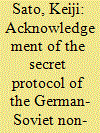

|
|
|
|
|
| Publication |
2014.
|
| Summary/Abstract |
In June 1989, the First Congress of People's Deputies of the Soviet Union established the Commission for Historical and Legal Estimation of the Soviet-German Non-aggression Pact of 1939. In the commission, representatives from Estonia, Latvia and Lithuania condemned the Soviet annexation of the Baltic States, prompting heated arguments regarding the invalidity of the related secret protocol of the pact with other members who continued to hold the traditional Soviet ideological view of the pact as something positive. The debate over the secret protocol had the further potential to extend to disputes over 'recovery of lost territory' amongst the Baltic States, Ukraine, Moldova, Belarus and Russia. This article analyses the arguments used by commission members, considering the interplay of national interests, how they balanced arguments between restoration of 'state sovereignty' and maintenance of borders, and how they finally compromised and concluded the commission's report.
|
|
|
|
|
|
|
|
|
|
|
|
|
|
|
|
| 2 |
ID:
130865
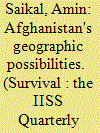

|
|
|
|
|
| Publication |
2014.
|
| Summary/Abstract |
Afghanistan's geostrategic potential is hampered by domestic weakness, regional tensions and major-power competition. Historically, Afghanistan's position at the junction between Asia and Europe has not only made it susceptible to outside invasions and influence, but also rendered it an important conduit for cross-continental interactions. The Greco-Bactrian (250-150 BCE), Kushan (30-375 AD) and Sassanid (224-651 AD) empires derived much of their wealth from the Silk Road, a series of interlinked trading networks criss-crossing the Eurasian land mass and centred around what is now known as Afghanistan. These routes served as the main arteries of east-west trade and transportation, until the disintegration of the Mongol Empire in 1368 AD effectively dismantled the network.
|
|
|
|
|
|
|
|
|
|
|
|
|
|
|
|
| 3 |
ID:
125599
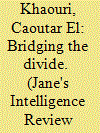

|
|
|
|
|
| Publication |
2013.
|
| Summary/Abstract |
The Islamist secular divide in Tusia has deepended in the midst of the deteriorating security situation, affecting democracy. Caoutar El Khaouri examines the likely outcome of the political crisis and the threat coming from Islamist -derived terrorisms
|
|
|
|
|
|
|
|
|
|
|
|
|
|
|
|
| 4 |
ID:
128269


|
|
|
|
|
| Publication |
2014.
|
| Summary/Abstract |
The study of Chinese political economy has experienced a sea change since the late 1990s; instead of debating the origins and direction of national reform, scholars have turned to examining the origins of local economic variation. This article reviews recent work in the regional political economy of contemporary China. In keeping with a movement in comparative politics toward analyzing subnational politics, the "new regionalists" seek to identify and explain meaningful heterogeneity in the Chinese polity and economy. Yet they go further than simply using subnational cases to generate or test theories about Chinese politics. Instead, they propose that subnational political economies in China are a function of endogenous change rather than a reaction to national priorities. After identifying differences between the "new regionalism" and previous studies of decentralization in China, the author discusses this work according to the theoretical approaches (institutional, ideational, and sociohistorical) used to explain the origins of regional differences. She concludes by examining the limitations of the new regionalist agenda in comparative and historical context and suggesting that scholars move past unconditional acceptance of the causal power of "socialist legacies" and instead attend to the importance of changes in the post-Mao administrative hierarchy.
|
|
|
|
|
|
|
|
|
|
|
|
|
|
|
|
| 5 |
ID:
132936
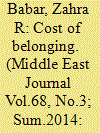

|
|
|
|
|
| Publication |
2014.
|
| Summary/Abstract |
In Qatar, processes of constructing citizenship have been strongly state-driven over the past four decades. This article reviews the primary in?uences on Qatari citizenship laws, including historical and contemporary social contexts that have impacted the development of relevant legislation. The article argues that the existing ?nancial privileges of Qatari citizenship as well as the presence of a dominant nonnational population have led to an ever more restrictive legal environment around access to citizenship.
|
|
|
|
|
|
|
|
|
|
|
|
|
|
|
|
| 6 |
ID:
126656
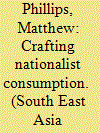

|
|
|
|
|
| Publication |
2013.
|
| Summary/Abstract |
Following the revolution of 1932 that ended absolute monarchy in Siam, a new government came into power that sought to legitimize its rule by encouraging mass identification with the state. Practically, the expansion of a wage economy and the development of a state-led education system were seen by government officials as central to promoting a sense of citizenship to as yet disinterested rural communities. Throughout its first decade in power, the government thus set up projects to provide such groups with skills that might contribute to their overall material advancement. Following the lead of similar endeavours, particularly in India, one of the principal ways in which it would do this was through the production and bringing to market of cotton textiles. However, with foreign imports both superior in quality and cheaper than anything produced internally, the state struggled to establish a public relations message that might convince consumers to purchase Thai-produced textiles. As a result of specific limitations rooted in Thailand's ambiguous status globally, this meant that Thai leaders struggled to replicate the success of such movements elsewhere
|
|
|
|
|
|
|
|
|
|
|
|
|
|
|
|
| 7 |
ID:
132515
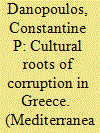

|
|
|
|
|
| Publication |
2014.
|
| Summary/Abstract |
Despite periods of growth, modern Greece is no stranger to severe and prolonged economic crises. Analyses of Greece's current economic crisis have stayed clear of the seminal importance of culture as a key variable responsible for widespread and persistent corruption that has deprived the country of a viable and sound economic foundation. This essay seeks to fill the void by concentrating of the cultural roots of corruption and the sources and factors that generate, nurture, and maintain high levels of corruption in the Greek setting. Borrowing from anthropological literature, the essay utilizes nine cultural dimensions of corruption: uncertainty avoidance, future orientation, institutional/societal collectivism, individual/in-group collectivism, human orientation, performance orientation, power distance, assertiveness, and gender egalitarianism.
|
|
|
|
|
|
|
|
|
|
|
|
|
|
|
|
| 8 |
ID:
129004
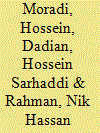

|
|
|
|
|
| Publication |
2014.
|
| Summary/Abstract |
This paper consists of some of the findings of the authors during their research at prehistoric sites of Bampur and its surrounding areas in August 2011. These areas, which have been introduced as Bampur-related sites, comprise an area about of 5-10 kilometers and belong to the Bronze Age. The paper introduces, categorizes and analyzes the archaeological findings in relation to the Bampur collection. The archaeological findings show that: (1) unlike the previous belief, there existed a peak settlement dated back to the Chah Husseini period which was prior to Bampur I; (2) in fact, Bampur II-IV had larger populations due to growth of trade and commerce and their relations with Yahya and Mesopotamia; (3) the later periods of the Bampur collection show a decreasing number of sites at Bampur VI.
|
|
|
|
|
|
|
|
|
|
|
|
|
|
|
|
| 9 |
ID:
132974
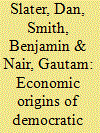

|
|
|
|
|
| Publication |
2014.
|
| Summary/Abstract |
From Aristotle to Acemoglu and Robinson, scholars have argued that democracy possesses powerful redistributive impulses, and imperils itself accordingly. We challenge the validity of the redistributive model of democratic breakdown in the postcolonial world-the only cases where democracies have collapsed since World War II-because its assumptions regarding state power are questionable or even inapplicable in postcolonial settings. Our correlative analysis of cross-sectional time series data from 139 countries between 1972 and 2007 indicates that, contrary to the expectations of the redistributive model, redistributive taxation is negatively associated with the incidence of military coups and the likelihood of democratic breakdown. Furthermore, authoritarian takeovers do not appear systematically to result in reduced redistribution from the rich. More fine-grained historical evidence from Southeast Asia-a region where the redistributive model should be especially likely to hold true-further affirms that authoritarian seizures of power are neither inspired by successful redistributive policies nor followed by their reversal. Taken together, these quantitative and qualitative data offer significant support for our central theoretical claim: contemporary democratic breakdowns have political origins in weak states, not economic origins in class conflict.
|
|
|
|
|
|
|
|
|
|
|
|
|
|
|
|
| 10 |
ID:
146773
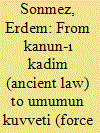

|
|
|
|
|
| Summary/Abstract |
This paper attempts to examine the prevailing scholarly view on the Young Ottoman and the Young Turk movements, which postulates that the concept of constitutionalism was solely and directly based on the western model, imported by the constitutionalist movements to the Ottoman Empire. As a child of the ‘modernization theory’, this approach mostly concentrates on European impact in an isolated manner, thus overlooking not only the manifold sources of the Ottoman constitutionalism, but also the means of legitimation that the Young Ottomans and the Young Turks cultivated. In view of this, I seek to shed light on the historical context of the Ottoman constitutionalism, by pointing out how the Young Ottomans and the Young Turks perceived the power struggles in the course of the seventeenth and eighteenth centuries, and built continuity between themselves and the political position that aimed to restrict the royal prerogative before the nineteenth century.
|
|
|
|
|
|
|
|
|
|
|
|
|
|
|
|
| 11 |
ID:
130233
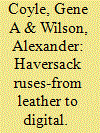

|
|
|
|
|
| Publication |
2014.
|
| Summary/Abstract |
The historical record of a country allowing false documents to fall into the hands of its enemy in order to deceive him goes back at least as far as the third century B.C., when Hannibal fought the Romans. 1 Yet, the ploy of misleading an enemy through the "passage" of fake documents to the other side probably reached its zenith during the twentieth century's First and Second World Wars, especially with a few spectacular cases involving an allegedly wounded courier and, once, even a dead one. Because of the famous British deception ploy in Palestine against the Turks in 1917, most all such deceptions came to be known as "haversack ruses." The king of all such ruses, at least in terms of being the best-known through numerous books and even a movie, was Operation MINCEMEAT of World War II. This elaborate British ploy of 1943 employed a dead body, a submarine to deliver it off the coast of Spain, false documents to deceive Germany's Adolf Hitler about the date and location of an anticipated Allied invasion of southern Europe, and the painstaking creation and backstopping of "The Man Who Never Was."
The purpose of examining variations of this type of ruse is to determine if these ploys featured any common characteristics, as well as any commonality in the backgrounds and personalities of the people who came up with or implemented such ideas. Did they include traits that make for a good deception officer? One of the World War II "deceivers," Sefton Delmer, wrote years later that, in wartime London, many of his most successful deception ideas came to him while drinking vintage champagne at Frascati's, his favorite expensive restaurant with its plush chairs and elderly waiters. 2
At first glance, the haversack ruses seem to have ended with the close of World War II, but perhaps the medium simply changed from leather satchels to digital ones. The challenge of looking at relatively recent "digital haversack" deceptions is that most instances remain classified, but a few Western ploys against the Soviet Union in the early 1980s have entered the public domain. The delivery methods of modern deceptions have changed, but the goal of misleading the enemy is still the same. Although no exciting tales involving dead bodies have surfaced-just the use of dull digital zeros and ones from computer files-the results may occasionally be equally exciting. And the need still exists for imaginative, operational minds in today's deception operations.
|
|
|
|
|
|
|
|
|
|
|
|
|
|
|
|
| 12 |
ID:
133011
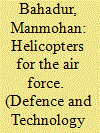

|
|
|
|
|
| Publication |
2014.
|
| Summary/Abstract |
On 10 March '2014,'the 104 helicopter Squadron of the Indian Air Force celebrated its Platinum Jubilee with a get together at Suratgarh where the Squadron is based. While the Platinum lubilee celebration of any ?ying outfit is an occasion to celebrate, there was a bigger reason for the commemorat' - it was also the day 60 years ago,w]_1 0 ' l" ' I first helicopter entered the in military service in India. And, just a few days later on 28 March 1954, Pandit Iawaharlal Nehru came to Palam and was flown to Tilpat range for the fire power demo of the IAF. So, like in everything connected with air power of the nation, the lAF was a trailblazer in the Rotary Wing field too.
|
|
|
|
|
|
|
|
|
|
|
|
|
|
|
|
| 13 |
ID:
132270
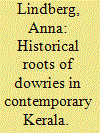

|
|
|
|
|
| Publication |
2014.
|
| Summary/Abstract |
Dowry payments from the family of the bride to that of the groom were rarely encountered in Kerala during the early twentieth century, but now are almost universal. Based on an examination of historical documents, including legislative debates, court cases, and reports, the way dowry was explained in the past is compared with the results of 200 contemporary interviews to determine its current rationale. Nowadays, making an obligatory payment for the maintenance of a wife, adherence to a social norm, and guaranteeing a woman's good treatment have displaced earlier arguments related to inheritance, status in the social hierarchy, or a woman's ability to provide for herself. Although several blurred traditions have been cited to account for dowries, they seem to have flourished in times of social inequity and uncertainty: the 1930s, 1970s, and 1990s. The emphasis on patriarchal nuclear families has created a mentality that a woman must pay for the privilege of being married and living securely.
|
|
|
|
|
|
|
|
|
|
|
|
|
|
|
|
| 14 |
ID:
131342


|
|
|
|
|
| Publication |
2014.
|
| Summary/Abstract |
Most theories of war and peace in the modern world, whether they acknowledge it or not, emerge from three historical questions. Why did the First World War break out? Was Hitler's Germany - and its murderous campaign of domination and destruction - unique? And how do nuclear weapons affect international relations? Coming first and producing a seemingly inexhaustible inheritance that vexes geopolitics to this day (think Syria), no international relations scholar can avoid wrestling with the causes of what was once called the Great War.
|
|
|
|
|
|
|
|
|
|
|
|
|
|
|
|
| 15 |
ID:
132287
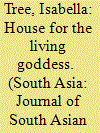

|
|
|
|
|
| Publication |
2014.
|
| Summary/Abstract |
In 2007, during the course of planning the 250th anniversary celebrations of the inauguration of the Kumari Chen-the house of the 'Living Goddess' in Kathmandu's Durbar Square-a new document came to light, which recorded significant alterations made to the building only four years after its foundation. This paper shows how these changes affected the Kumari Chen's identity, transforming it from a building originally designed for royal Hindu Tantric worship to a building with dual purpose, where separate Hindu and Buddhist Tantric worship could take place under the same roof. Taking into account the historical context in which the Kumari Chen was established, this paper explores the purpose for which the building was created by the last Malla king of Kathmandu and identifies motives for the subsequent alterations, shedding light on the relationship between Newar Buddhists and their Hindu king in a time of unprecedented crisis.
|
|
|
|
|
|
|
|
|
|
|
|
|
|
|
|
| 16 |
ID:
131344
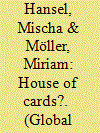

|
|
|
|
|
| Publication |
2014.
|
| Summary/Abstract |
India has always been a major troop contributor to UN peacekeeping missions. In recent years, however, the benefits of these efforts have been increasingly questioned by some of the country's strategic elites, as are some of the guiding norms of contemporary peace operations. This article scrutinizes the contemporary and historical plausibility of both ideational and materialistic explanations of India's comprehensive peacekeeping engagement. Against this backdrop, it provides an estimation of the likelihood of a future Indian retreat from these efforts. Our conclusions are neither reassuring nor alarmist. Status and economic considerations, normative disagreements, and growing frustration with the stalemate of UN reforms all complicate India's peacekeeping policies. Neither of them, however, unambiguously hints at a complete withdrawal.
|
|
|
|
|
|
|
|
|
|
|
|
|
|
|
|
| 17 |
ID:
144019
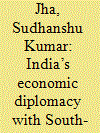

|
|
|
|
|
| Summary/Abstract |
There is no gainsaying the fact that India is emerging as a leading economic power. Economy picks up pace and poverty continues to decrease. India grew 6.3 per cent per annum during 1988-2006 and has registered stupendous annual average of more than 7 per cent since 2006.
|
|
|
|
|
|
|
|
|
|
|
|
|
|
|
|
| 18 |
ID:
128434
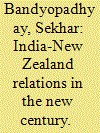

|
|
|
|
|
| Publication |
2013.
|
| Summary/Abstract |
India-New Zealand relations, which could be historically dated back to the days of the British Empire, lacked until recently in substance and were rocked by several irritants, the most important of which were the divergent views on the issue of nuclear non-proliferation. However, in last one decade or so there have been some remarkable developments in this bilateral relation, as the security interests of the two nations have converged, volume of trade increased, educational ties grew stronger and people-to-people contacts improved significantly. While there still remain some challenges, as negotiations for a Free Trade Agreement have taken longer time than expected, there are also immense possibilities. This essay looks critically at those challenges and possibilities in the relationship between two countries, which on the one hand share some historic common grounds, but are also set apart by geography as well as numerous systemic dissimilarities.
|
|
|
|
|
|
|
|
|
|
|
|
|
|
|
|
| 19 |
ID:
129197
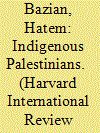

|
|
|
|
|
| Publication |
2014.
|
| Summary/Abstract |
On November 10th, 2013, the Israeli cabinet voted in a special session to authorize the demolition and removal of Umm al-Hiran, an "unauthorized," Palestinian Bedouin village in the Negev Desert, and to build in its place a new community for national Jews to be named Hiran, which had been planned and approved in early 2002. The stated reason for this demolition and forceful eviction is the lack of permits for the existing settlement, with Umm al-Hiran being one of a number of Palestinian Bedouin communities that were settled without permits and are currently subject to intense Israeli plans for removal. Umm al-Hiran itself was set-up in early 1956 by the Palestinian Abu-Alkian tribe after they had been forced to move from their ancestral tribal lands near Kibbutz Shoval in the Northern Negev.
A more critical development related to this event is the Israeli Parliament's passing of the first reading of the Prawer law. If the plan wins final approval, as it appears it will, it would cause the forceful displacement of 40,000-70,000 Arab Bedouins from the Negev, the confiscation of 800,000 dunams of Arab land, the razing to the ground of 36 or more Arab villages, and the dispossession of another generation of Palestinians. According to Adallah, the Legal Center for Arab Minority Rights in Israel, the "underlying premise of the draft bill is that there is no Bedouin land ownership," effectively negating the "population's right to property and historic affinity to the land." At the heart of this matter is the ongoing contestation of Palestinian land rights, with the Israeli government using its authority to define these policies to favor the Jewish population over the Arab. Thus, this bill, like others before it, "promotes the principle of segregation along the lines of ethnic affiliation and labeling."
|
|
|
|
|
|
|
|
|
|
|
|
|
|
|
|
| 20 |
ID:
132331
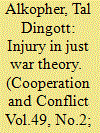

|
|
|
|
|
| Publication |
2014.
|
| Summary/Abstract |
The paper traces the evolution of just war discourse and its historicity. Taking St Augustine's crucial definition of just war as a war to avenge injuries as our starting point, we focus on the concept of injury in 'just war' discourse. The genealogy of the notion of injury is traced through the continuities, ruptures, and leaps in the evolution of its meaning, starting from the conceptualization of just war in medieval thinking to its manifestation in feminist thought. It specifically explores two aspects of the way injury is conceptualized: the meaning ascribed to the actual concept of injury and, secondly, the constructed appropriate reaction to injury. In conclusion, we assess how far injury is indeed socially constructed and try to determine the impact of its socially constructed meaning on just war thinking and possibly warlike practices.
|
|
|
|
|
|
|
|
|
|
|
|
|
|
|
|
|
|
|
|
|